So, you have decided to join the digital movement and want to address issues related to legacy systems. Knowing and addressing the top digital transformation challenges is essential before creating a digital transformation strategy or roadmap.
Importance of digital transformation for businesses
Digital transformation has become a critical factor for businesses aiming to stay competitive in the modern market. By integrating digital technology into all areas of business, organizations can streamline operations, improve efficiency, and enhance customer experiences.
This transformation goes beyond mere technological upgrades; it requires a fundamental shift in business processes, culture, and customer interactions. In today's competitive and fast-paced digital age, businesses that fail to embrace digital transformation risk falling behind their competitors.
Digital transformation allows companies to leverage advanced technologies, such as AI, IoT, and data analytics, to optimize their operations, drive innovation, and deliver superior value to customers.
Additionally, it enables organizations to respond more quickly to market changes and customer demands, ensuring they remain agile and resilient.
Read our ultimate guide on digital transformation: Digital Transformation Guide: An In-Depth Review for Undertaking Organizational Digitization Initiative
Benefits of digital transformation for modern businesses
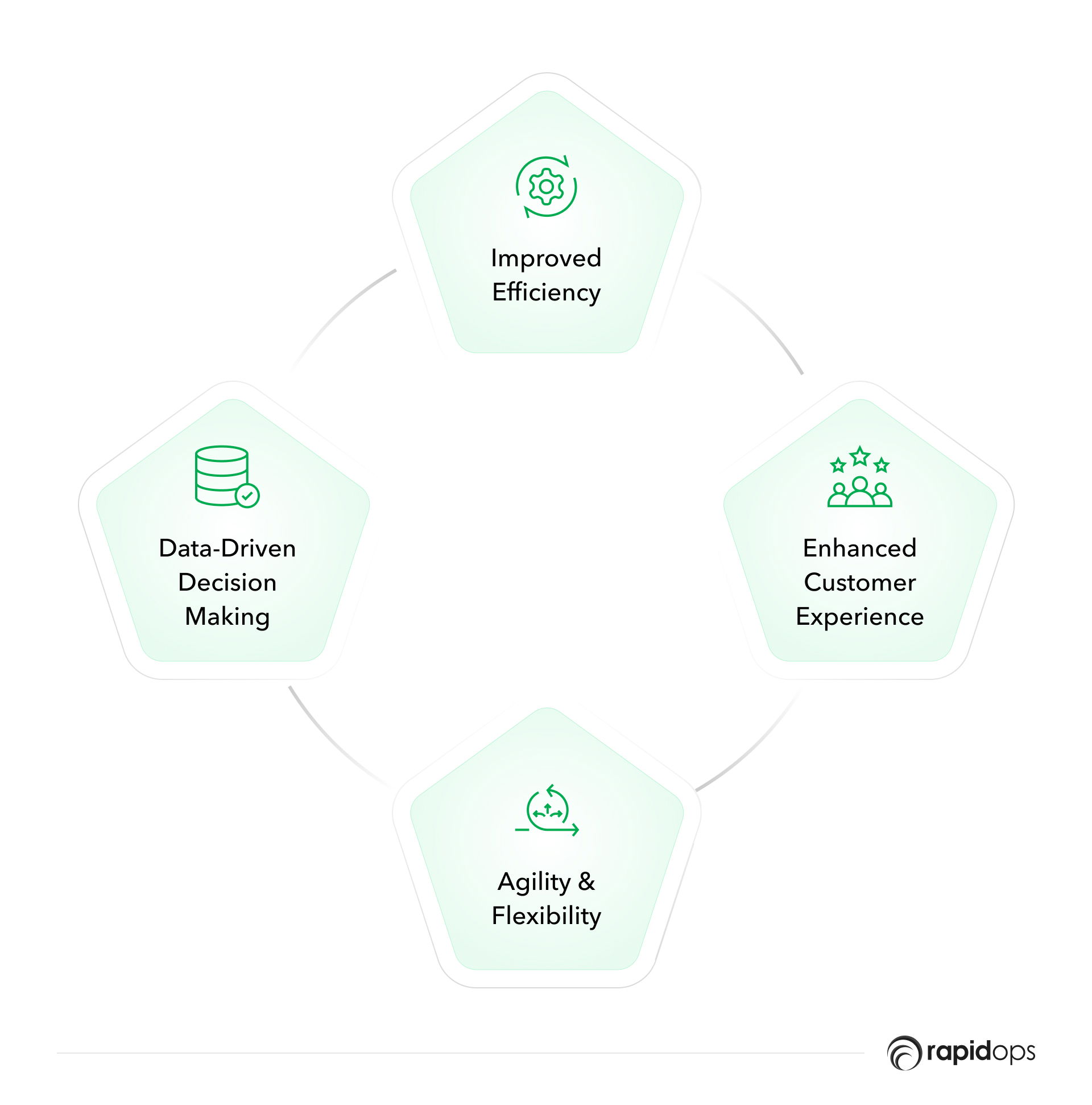
Digital transformation offers numerous benefits, including:
1. Improved efficiency
Automating routine tasks and optimizing processes reduce operational costs and increase productivity. For example, automating invoice processing can significantly reduce the time and effort required to manage accounts payable, leading to cost savings and increased accuracy.
2. Enhanced customer experience
Personalized and seamless customer interactions lead to higher satisfaction and loyalty.
Implementing a customer relationship management (CRM) system allows businesses to track customer preferences and interactions, enabling personalized marketing and improved service delivery.
3. Data-driven decision making
Advanced analytics provide insights that drive strategic decisions and foster innovation.
By analyzing customer data, businesses can identify trends and preferences, allowing them to tailor their offerings and marketing strategies to better meet customer needs.
4. Agility and flexibility
Businesses can quickly adapt to market changes and emerging opportunities.
Cloud-based solutions enable organizations to scale their operations up or down as needed, providing the flexibility to respond to changing market conditions and business needs.
Discover the Keys to Digital Transformation Success with Our Comprehensive Guide.
Download Now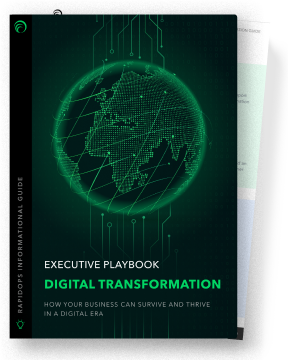
Common digital transformation challenges
Digital transformation is not just about integrating cutting-edge technologies into the business mix. It is about understanding which process requires innovation, where automation will profit the business, and where technology can improve customer experience.
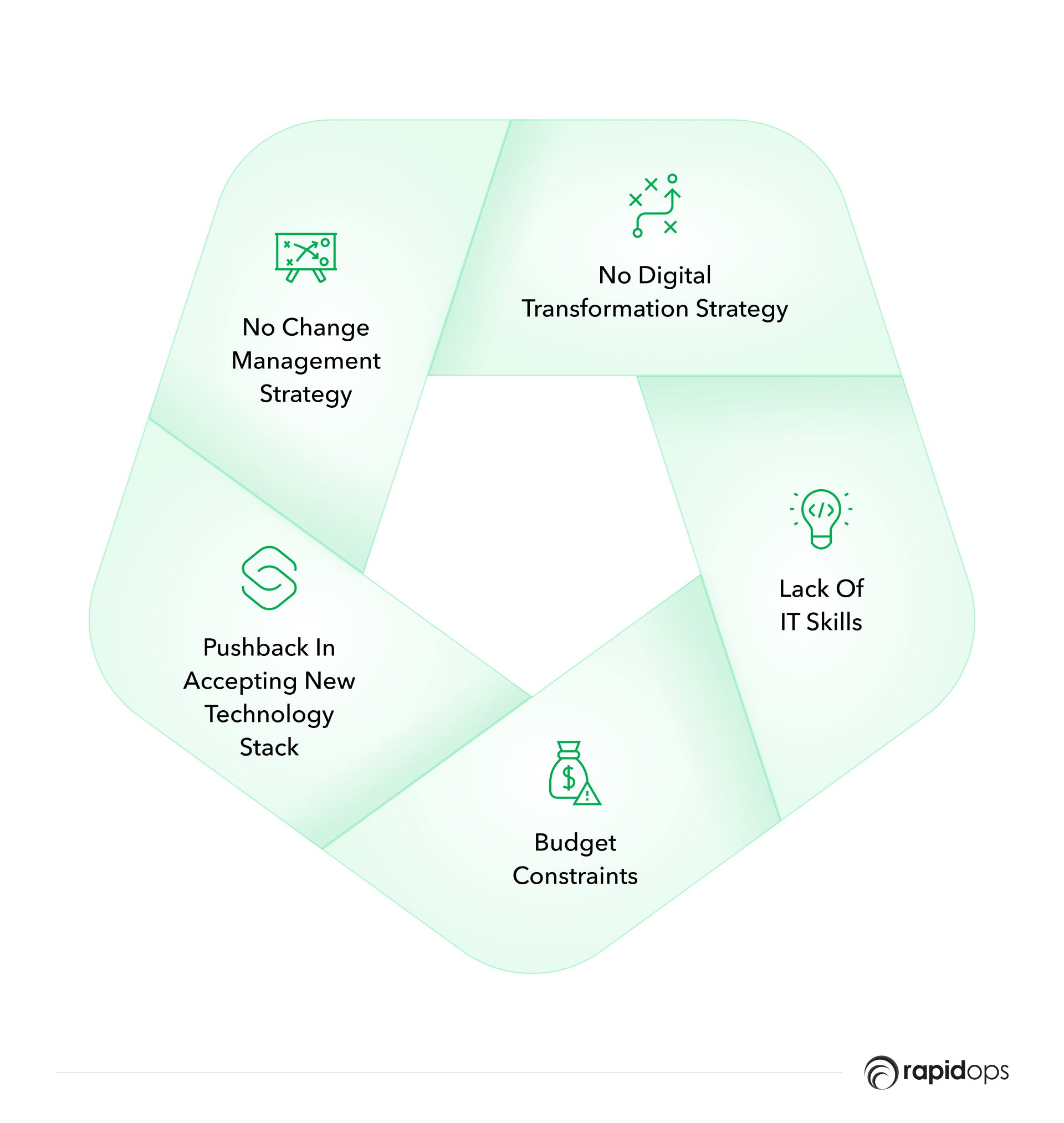
1. No digital transformation strategy
The following questions must be answered before implementing any digital transformation strategy.
- Why did the need to modernize the legacy systems and automate your manual processes arise?
- Does your organization plan to implement an advanced technological stack?
- Is your business well prepared to migrate the existing systems into modernized ones?
Without creating a digital transformation strategy, the success of a digital project is not guaranteed. Never rely too much on any false assumptions or fancy terminology.
Businesses must find areas where they can improve their organization's process and the areas that need immediate digital upgrades.
2. Lack of IT skills
54% of organizations said they could not accomplish their digital transformation goals because of a lack of technically-skilled employees. – Harvey Nash Group
Finding a skilled and high-performing IT team is another challenge organizations face while implementing digital transformation efforts. The current work-from-home environment is a major challenge for businesses trying to find the right IT workforce for their digital transformation initiative.
The significant challenges that are put in front of modern organizations wanting to take digital transformation initiatives are lack of skill sets in
- Cybersecurity
- Application Architecture
- Software integrations
- Data Analytics
- Data migration
Organizations that lack IT professionals with these skill sets face roadblocks while implementing their digital transformation strategy.
3. Budget constraints
Budget is a significant pain point and often a challenge for digital transformation. Yes, investments in a new technology stack are hefty and should be considered completely before digitalizing.
Plus, when an organization already feels budget pushback, a transformation strategy will only make things tricky and add more delay to the entire digital transformation initiative.
4. Pushback in accepting new technology stack
New technologies are intimidating, and enterprise solutions are inherently complex. With legacy systems and manual processes integrated into an organization's core process, changes often occur much slower.
Such an organization will have difficulty convincing the workforce about the benefits of automation and training them on new technologies.
5. No change management strategy
When you think of transforming the business, you think of including the latest tech stack that assists you in making profitable decisions. Throw in using new tools, combine them with employee resistance, and you can see the digital transformation initiative fail.
This is where the lack of a change management strategy abruptly spoils digital transformation efforts. Sometimes, businesses are so focused on the technical aspects that they overlook or fail to consider the workforce that will directly be affected by the initiative.
Overcoming digital transformation challenges
Successfully navigating the digital transformation journey requires addressing the common challenges organizations face. By implementing effective strategies and leveraging the right tools, businesses can overcome these obstacles and achieve their transformation goals.
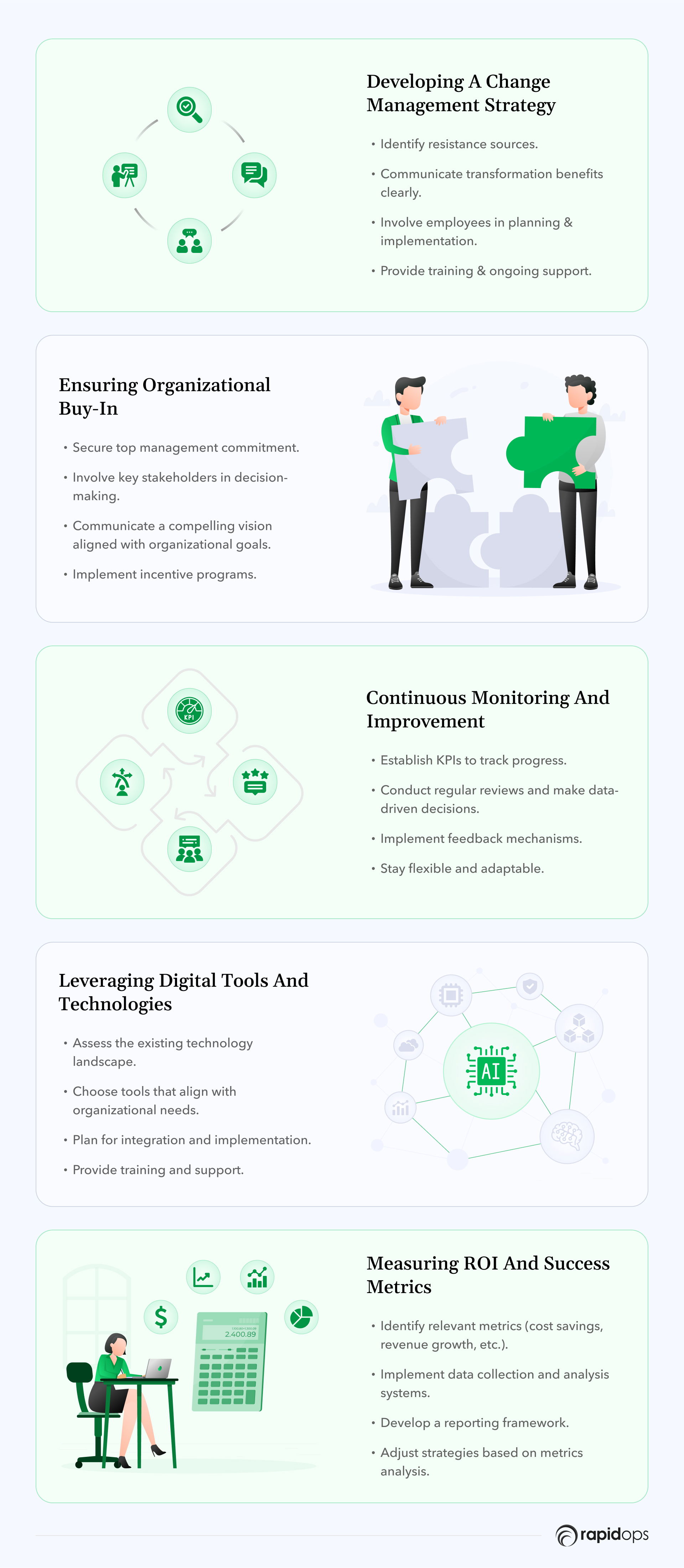
1. Developing a change management strategy
A robust change management strategy is essential for addressing resistance and ensuring a smooth transition. Change management involves preparing, supporting, and helping individuals, teams, and organizations to make organizational changes.
- Understanding resistance to change: Identify the sources of resistance, such as fear of job loss, lack of understanding, or discomfort with new technologies.
- Communication plan: Develop a clear and consistent communication plan to inform all stakeholders about the transformation, its benefits, and its impact.
- Employee involvement: Involve employees in the planning and implementation phases to increase buy-in and reduce resistance.
- Training and support: Provide comprehensive training and ongoing support to help employees adapt to new technologies and processes.
2. Ensuring organizational buy-in
Gaining organizational buy-in is crucial for the success of digital transformation initiatives. This involves securing support from leadership, stakeholders, and employees.
- Leadership commitment: Ensure that top management is fully committed to the transformation and actively participates in the process.
- Stakeholder engagement: Identify key stakeholders and involve them in decision-making to ensure their support and alignment with the transformation goals.
- Creating a vision: Develop a compelling vision for the transformation that aligns with the organization's mission and goals and communicate it effectively to all employees.
- Incentives and recognition: Implement incentive programs to motivate employees and recognize their contributions to the transformation process.
3. Continuous monitoring and improvement
Digital transformation is an ongoing process that requires continuous monitoring and improvement. This involves regularly assessing progress, identifying areas for improvement, and making necessary adjustments.
- Setting key performance indicators (KPIs): Establish KPIs to measure the success of the transformation initiatives and track progress.
- Regular reviews: Conduct regular reviews to evaluate the effectiveness of the transformation efforts and make data-driven decisions.
- Feedback mechanisms: Implement feedback mechanisms to gather input from employees and stakeholders and use this feedback to improve processes and strategies.
- Adaptability: Stay flexible and adaptable to changing market conditions, technological advancements, and organizational needs.
4. Leveraging digital tools and technologies
The right digital tools and technologies can significantly enhance the effectiveness of digital transformation initiatives. Organizations must carefully select and implement these tools to support their transformation goals.
- Technology assessment: Conduct a thorough assessment of the existing technology landscape and identify gaps and opportunities for improvement.
- Tool selection: Choose digital tools that align with the organization's needs and goals and have a proven track record of success.
- Integration and implementation: Develop a detailed plan for integrating and implementing new technologies, including timelines, resource allocation, and potential risks.
- Training and adoption: Provide training and support to ensure successful adoption and utilization of the new tools.
5. Measuring ROI and success metrics
Measuring the return on investment (ROI) and success metrics is essential for evaluating the effectiveness of digital transformation initiatives. This involves defining clear metrics and regularly assessing performance.
- Defining success metrics: Identify specific metrics that align with the organization's goals, such as cost savings, revenue growth, operational efficiency, and customer satisfaction.
- Data collection and analysis: Implement systems for collecting and analyzing data related to the transformation initiatives.
- Regular reporting: Develop a reporting framework to communicate progress and results to stakeholders and use these reports to inform decision-making.
- Adjusting strategies: Based on the analysis of success metrics, adjust strategies and initiatives to optimize performance and achieve desired outcomes.
Digital transformation strategy and roadmap
A comprehensive digital transformation strategy and a well-structured roadmap are critical for guiding an organization through its transformation journey. These elements provide a clear vision, align digital initiatives with business objectives, and ensure effective resource allocation.
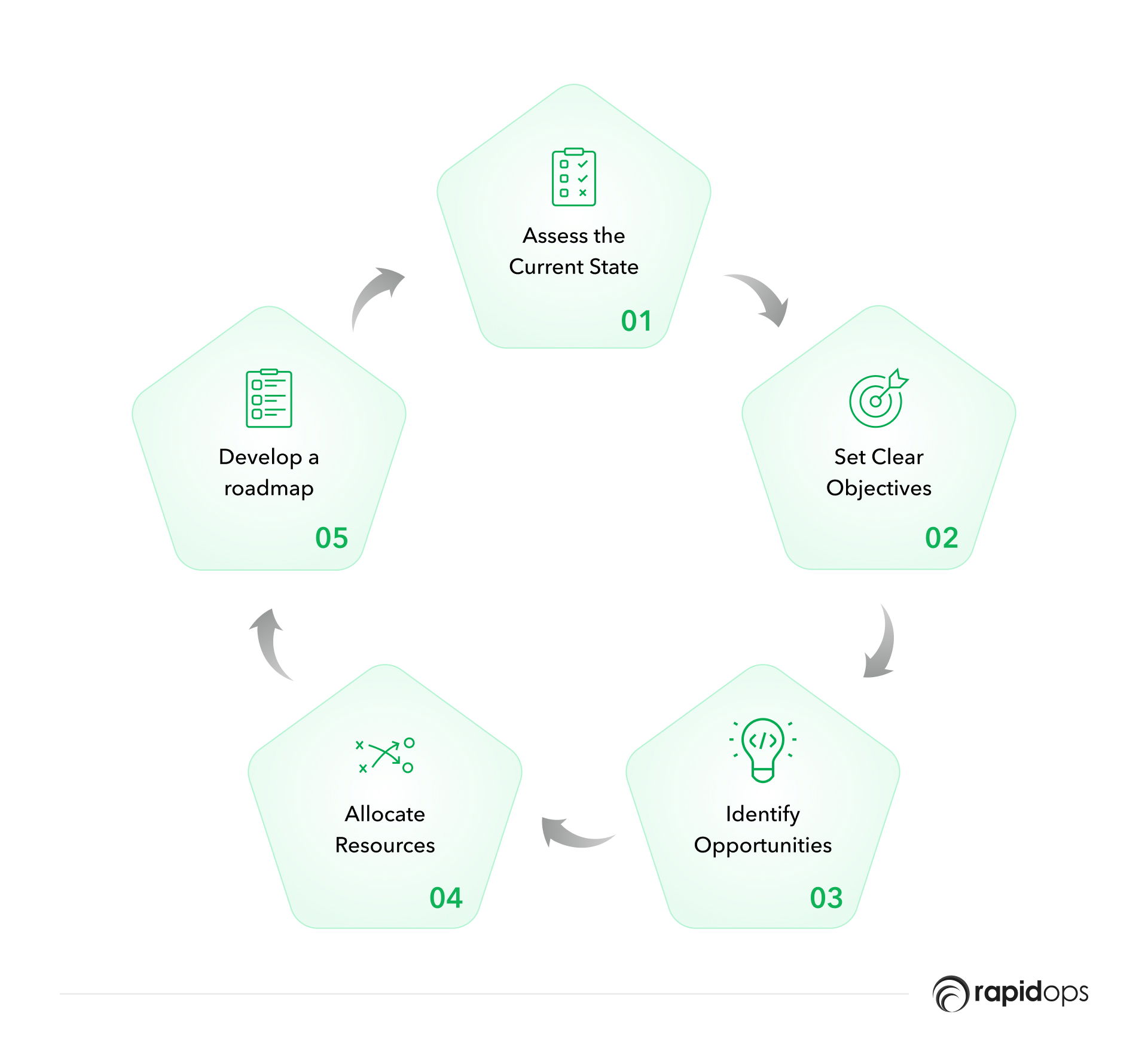
Here are the steps involved in creating a comprehensive digital transformation strategy.
1. Assessment of current state
- Evaluate existing processes, technologies, and capabilities.
- Identify inefficiencies and areas for improvement.
2. Setting clear objectives
- Define specific, measurable, achievable, relevant, and time-bound (SMART) goals.
- Align these objectives with the overall business strategy.
3. Identifying opportunities
- Pinpoint areas where digital technologies can add value.
- Consider opportunities for automation, data analytics, and enhanced customer experiences.
4. Resource allocation
- Determine the resources required for implementation, including budget, personnel, and technology.
- Allocate funds strategically to ensure maximum impact.
5. Roadmap development
- Create a detailed roadmap outlining the steps and timeline for the transformation.
- Include milestones, deliverables, and key performance indicators (KPIs) to track progress.
What successful digital transformation looks like
Examining real-world examples of successful digital transformations can provide valuable insights and inspiration for businesses embarking on their transformation journeys. Here, we explore case studies of companies across various industries, highlighting the challenges they faced, the solutions they implemented, and the outcomes they achieved.
1. Sephora: Enhancing customer experience with digital innovation

Challenge: Creating a personalized and engaging shopping experience both online and in-store.
Sephora aimed to bridge the gap between online and in-store experiences to provide a seamless and personalized journey for its customers. The challenge was to integrate digital technologies that could enhance customer interaction and satisfaction across all touchpoints.
Solution: Implementing an omnichannel strategy that includes a mobile app, virtual try-on tools, and a robust online loyalty program.
- Mobile app: Sephora's app offers features such as personalized recommendations, beauty tutorials, and a virtual artist tool that allows customers to try on products virtually.
- Virtual try-on tools: In-store and online tools enable customers to see how products will look at them before purchasing.
- Online loyalty program: The Beauty Insider program tracks customer preferences and purchase history, offering personalized rewards and recommendations.
Result: Increased customer engagement, higher sales, and improved customer loyalty.
- Increased engagement: The mobile app and virtual try-on tools have significantly enhanced customer engagement, with more users interacting with the brand digitally.
- Higher sales: The omnichannel strategy has led to an increase in both online and in-store sales.
- Improved loyalty: The loyalty program has boosted customer retention and satisfaction, with members spending more per visit than non-members.
2. Siemens: Leveraging IoT for smart manufacturing

Challenge: Improving efficiency and reducing downtime in manufacturing operations.
Siemens needed to enhance its manufacturing processes by reducing downtime and increasing operational efficiency. The challenge was to implement technologies that could monitor and optimize production in real-time.
Solution: Adopting IoT sensors and analytics to monitor equipment and optimize maintenance schedules.
- IoT sensors: Installed across manufacturing equipment to collect real-time data on performance and health.
- Predictive analytics: Analyzed data to predict equipment failures and schedule maintenance proactively.
Result: Enhanced operational efficiency, reduced downtime, and significant cost savings.
- Operational efficiency: The use of IoT sensors and analytics has streamlined production processes, improving overall efficiency.
- Reduced downtime: Predictive maintenance has significantly reduced unplanned downtime, leading to smoother operations.
- Cost savings: The proactive approach to maintenance has resulted in considerable cost savings by preventing major equipment failures and optimizing resource use.
3. Domino's Pizza: Revolutionizing the ordering process with technology

Challenge: Simplifying the ordering process and reducing wait times for customers.
Domino's Pizza sought to enhance its customer experience by making the ordering process more convenient and efficient. The challenge was to integrate multiple digital ordering platforms that could cater to diverse customer preferences.
Solution: Introducing multiple digital ordering platforms, including a mobile app, social media integrations, and voice-activated ordering.
- Mobile app: Offers features such as order tracking, personalized recommendations, and easy reordering.
- Social media integrations: Customers can place orders through platforms like Facebook and Twitter.
- Voice-activated ordering: Enables customers to place orders using voice commands through smart speakers like Amazon Echo.
Result: Faster order processing, increased customer satisfaction, and growth in digital sales.
- Faster processing: The digital platforms have streamlined the ordering process, reducing wait times and improving service speed.
- Increased satisfaction: Customers appreciate the convenience and flexibility of multiple ordering options.
- Growth in sales: Digital sales have grown significantly, contributing to overall revenue growth.
4. Rolls-Royce: Using big data for predictive maintenance in aviation

Challenge: Reducing maintenance costs and improving the reliability of aircraft engines.
Rolls-Royce aimed to enhance the reliability of its aircraft engines while reducing maintenance costs. The challenge was to leverage data analytics to predict maintenance needs and prevent unexpected failures.
Solution: Implementing a big data analytics platform to monitor engine performance and predict maintenance needs.
- Data collection: Sensors installed on aircraft engines collect vast amounts of performance data.
- Analytics platform: Analyzes data to identify patterns and predict maintenance requirements.
- Real-time monitoring: Provides real-time insights into engine health, allowing for proactive maintenance planning.
Result: Improved engine reliability, reduced maintenance costs, and increased operational efficiency.
- Reliability: Predictive maintenance has enhanced the reliability of Rolls-Royce engines, reducing the risk of in-flight failures.
- Cost reduction: The analytics platform has significantly reduced maintenance costs by optimizing maintenance schedules and preventing unnecessary repairs.
- Operational efficiency: Real-time monitoring has improved the overall efficiency of maintenance operations, ensuring aircraft are available for service more frequently.
5. Starbucks: Personalizing customer experience with data analytics

Challenge: Enhancing customer loyalty and increasing sales through personalized marketing.
Starbucks aimed to deepen customer engagement and boost sales by leveraging customer data for personalized marketing. The challenge was to create a system that could analyze customer preferences and deliver targeted promotions effectively.
Solution: Implementing a data analytics platform to analyze customer behavior and personalize marketing efforts.
- Customer data collection: Aggregates data from purchases, app usage, and loyalty program interactions.
- Analytics platform: Uses machine learning algorithms to analyze data and generate insights into customer preferences.
- Personalized marketing: Delivers targeted promotions and recommendations through the Starbucks app and email campaigns.
Result: Increased customer loyalty, higher sales, and improved customer experience.
- Loyalty: Personalized marketing efforts have strengthened customer loyalty, with members of the Starbucks Rewards program showing higher retention rates.
- Sales growth: Targeted promotions have led to an increase in sales, with customers responding positively to personalized offers.
- Customer experience: The data-driven approach has enhanced the overall customer experience, making interactions with Starbucks more relevant and engaging.
Concluding thoughts
With the help of a well-executed transformation roadmap and by overcoming the challenges of digital transformation, businesses can propel their operational efficiency, stay innovative, and compete vigorously against all odds.
Important note: More than the implementation of technology, digital transformation is about reimagining business processes, culture, and customer experiences to thrive in the digital age.
At Rapidops, we have extensive experience helping organizations at every stage of their digital transformation journey. Our pragmatic approach ensures that your business is prepared for future disruptions while achieving immediate benefits.
Discover how our digital transformation services can support your business goals. Schedule a cost-free consultation with our experts to discuss your specific needs and challenges. You can also learn from our client's success stories and see how we have helped them achieve their transformation goals.

Saptarshi Das
Content Editor
9+ years of expertise in content marketing, SEO, and SERP research. Creates informative, engaging content to achieve marketing goals. Empathetic approach and deep understanding of target audience needs. Expert in SEO optimization for maximum visibility. Your ideal content marketing strategist.
What’s Inside
- Importance of digital transformation for businesses
- Benefits of digital transformation for modern businesses
- Common digital transformation challenges
- Overcoming digital transformation challenges
- Digital transformation strategy and roadmap
- What successful digital transformation looks like
- Concluding thoughts

Let’s build the next big thing!
Share your ideas and vision with us to explore your digital opportunities
Similar Stories
- Transformation
- undefined Mins
- March 2022

- Transformation
- undefined Mins
- March 2020


Receive articles like this in your mailbox
Sign up to get weekly insights & inspiration in your inbox.

